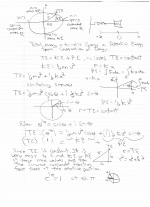At theta = pi, the spring is compressed to its maximum value of displacement x, velocity = 0, acceleration = max (decel at that point, max negative accel).
So you can say it is at position x = -1. But the radius, or the triangle hypoteneuse representing total energy, is constant (1 for the unit circle) and at max compression the spring potential energy, is also a positive value (PE = 1, KE = 0). Summing the right hand side using Pythagoras gives the correct value of e^i(pi) = 1.
The book is wrong.
So you can say it is at position x = -1. But the radius, or the triangle hypoteneuse representing total energy, is constant (1 for the unit circle) and at max compression the spring potential energy, is also a positive value (PE = 1, KE = 0). Summing the right hand side using Pythagoras gives the correct value of e^i(pi) = 1.
The book is wrong.



